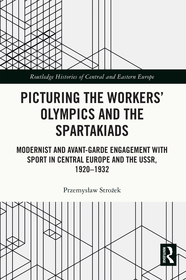
Picturing the Workers' Olympics and the Spartakiads
Modernist and Avant-Garde Engagement with Sport in Central Europe and the USSR, 1920-1932
Sorozatcím: Routledge Histories of Central and Eastern Europe;
-
10% KEDVEZMÉNY?
- A kedvezmény csak az 'Értesítés a kedvenc témákról' hírlevelünk címzettjeinek rendeléseire érvényes.
- Kiadói listaár GBP 39.99
-
19 105 Ft (18 195 Ft + 5% áfa)
Az ár azért becsült, mert a rendelés pillanatában nem lehet pontosan tudni, hogy a beérkezéskor milyen lesz a forint árfolyama az adott termék eredeti devizájához képest. Ha a forint romlana, kissé többet, ha javulna, kissé kevesebbet kell majd fizetnie.
- Kedvezmény(ek) 10% (cc. 1 911 Ft off)
- Kedvezményes ár 17 194 Ft (16 376 Ft + 5% áfa)
Iratkozzon fel most és részesüljön kedvezőbb árainkból!
Feliratkozom
19 105 Ft

Beszerezhetőség
Becsült beszerzési idő: A Prosperónál jelenleg nincsen raktáron, de a kiadónál igen. Beszerzés kb. 3-5 hét..
A Prosperónál jelenleg nincsen raktáron.
Why don't you give exact delivery time?
A beszerzés időigényét az eddigi tapasztalatokra alapozva adjuk meg. Azért becsült, mert a terméket külföldről hozzuk be, így a kiadó kiszolgálásának pillanatnyi gyorsaságától is függ. A megadottnál gyorsabb és lassabb szállítás is elképzelhető, de mindent megteszünk, hogy Ön a lehető leghamarabb jusson hozzá a termékhez.
A termék adatai:
- Kiadás sorszáma 1
- Kiadó Routledge
- Megjelenés dátuma 2024. május 27.
- ISBN 9781032017594
- Kötéstípus Puhakötés
- Terjedelem232 oldal
- Méret 234x156 mm
- Súly 453 g
- Nyelv angol
- Illusztrációk 112 Illustrations, black & white; 112 Halftones, black & white 655
Kategóriák
Rövid leírás:
This volume focuses on the modernist and avant-garde engagement with workers’ sport events that were organised or were planned to be organised in the cities of Central Europe and the USSR in the period of 1920-1932: Frankfurt am Main – Vienna – Moscow – Prague – Budapest – Berlin.
TöbbHosszú leírás:
This volume focuses on the modernist and avant-garde engagement with workers’ sport events that were organised or were planned to be organised in the cities of Central Europe and the USSR in the period of 1920–1932: Frankfurt am Main – Vienna – Moscow – Prague – Budapest – Berlin.
During the 1920s and 1930s, two organisations of workers’ sport operated: the Lucerne Sport International/Socialist Workers’ Sport International and the Red Sport International, which held the socialist Workers’ Olympics and the communist Spartakiads, respectively. These events were not aimed at cultivating national victories and individual athletic records, but at mobilising workers for the class struggle and at creating new culture for the working class. This book examines the visual propaganda of the Workers’ Olympics and the Spartakiads expressed through paintings, sculptures, prints, illustrations, posters, postcards, photomontages, photographs, films, theatre and architectural projects. It emphasises the significance of workers’ sport for the artistic and social changes within a utopian project of a new culture, as visualised by the modernist and avant-garde artists, including Varvara Stepanova, Gustav Klucis, and Otto Nagel.
This volume is of great use to students and scholars of the history of sport, art history and cultural history in interwar Europe and the Soviet Union.
TöbbTartalomjegyzék:
1. The New Great Power. The First Workers’ Olympics in Frankfurt am Main as a Socialist Olympia, 1925 2. The Giants at the Prater Stadium. Visualising the Second Workers’ Olympics in the Socialist Paradise: the Red Vienna, 1931 3. ‘Every Worker-Athlete Must be a Soldier of the Revolution’. From Vsevobuch to Gustav Klucis’s Spartakiada series, 1928 4. The Communist Workers’ Sport for the Revolution, for the Proletariat, for the People. Devětsil, FPT and the Visual Propaganda of the Second Spartakiad in Prague, 1928 5. The Collective Embodiment of the Red Man. Workers’ Physical Training Association, Munka Circle and Worker Photography in Budapest 6. ‘Overcoming all Obstacles – Red Sport!’ Visualising solidarity and hope for Communist Sport in Berlin, 1931-1932 7. Conclusion
Több



